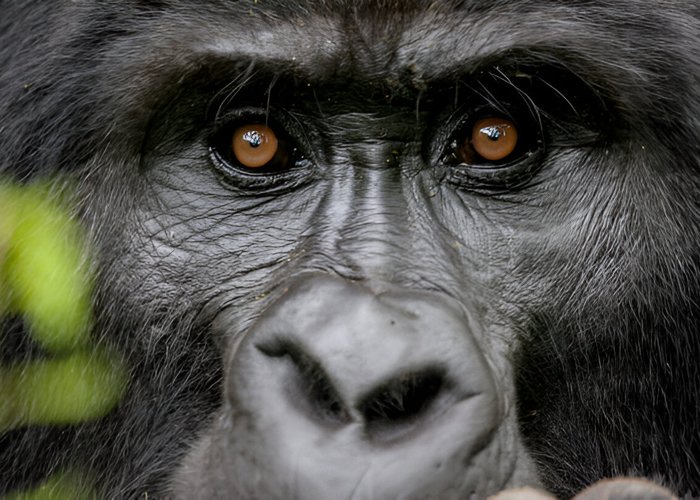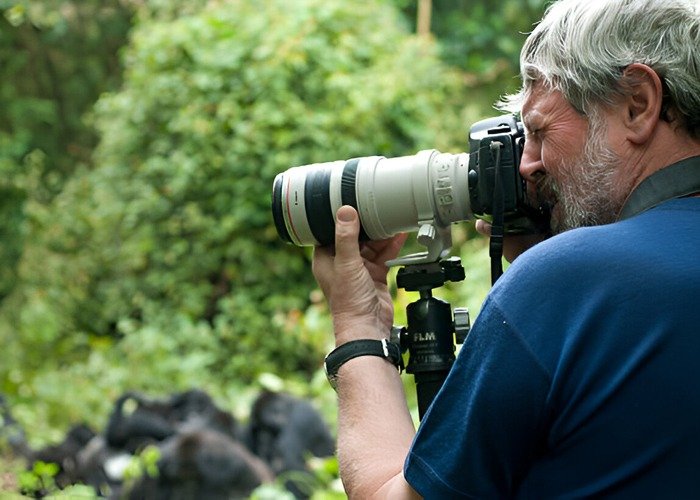
Capturing the essence of mountain gorillas in Uganda through photography is a dream for many wildlife photographers. These majestic creatures, with their expressive eyes and powerful presence, provide a unique subject for photography.
However, photographing gorillas in their natural habitat can be challenging. This blog will provide expert photography tips to help you capture stunning images of mountain gorillas in Uganda.
1. Understanding Your Subject: Mountain Gorillas

Mountain gorillas are one of the most endangered species in the world, with only about 1,000 individuals remaining.
Uganda is home to over half of this population, primarily in Bwindi Impenetrable National Park and Mgahinga Gorilla National Park.
Understanding their behavior, habitat, and social structure can greatly enhance your photography.
Know Their Behavior
Mountain gorillas are social animals that live in family groups led by a dominant male known as the silverback. They spend most of their time foraging, playing, and grooming each other.
Observing their behavior before taking photos can help you anticipate their movements and capture more dynamic shots.
2. Preparing Your Gear
The right gear can make a significant difference in the quality of your photos. Here?s what you?ll need:
Camera and Lenses

- DSLR or Mirrorless Camera: These cameras offer better control over settings and higher image quality.
- Telephoto Lens: A lens with a focal length of 70-200mm or 100-400mm is ideal for capturing close-ups without disturbing the gorillas.
- Wide-Angle Lens: Useful for capturing the gorillas in their environment.
- Spare Batteries and Memory Cards: Ensure you have plenty of backup as you’ll be in the field for several hours.
Accessories
- Tripod or Monopod: Helps stabilize your camera, especially in low-light conditions.
- Lens Hood: Reduces glare and protects your lens from rain and dust.
- Rain Cover: Uganda?s weather can be unpredictable, so a rain cover is essential to protect your gear.
3. Camera Settings for Gorilla Photography

Understanding your camera settings is crucial for capturing sharp and well-exposed images.
ISO
Set your ISO to a higher value (e.g., 800-1600) as the forest canopy often limits the amount of light. This will help you maintain a faster shutter speed and avoid blurry images.
Shutter Speed
A fast shutter speed (1/250 sec or faster) is recommended to freeze the movement of the gorillas, especially if they are active.
Aperture
Use a wide aperture (f/2.8 – f/5.6) to achieve a shallow depth of field. This will help to isolate your subject from the background and create a beautiful bokeh effect.
Focus Mode
Use continuous autofocus mode (AI Servo/AF-C) to keep moving subjects in focus. Select a single focus point to ensure sharpness on the gorilla’s eyes.
4. Composing Your Shots

Composition is key to creating visually appealing photos. Here are some tips:
Rule of Thirds
Place the gorilla off-center, along the lines or at the intersections of the rule of thirds grid. This creates a more balanced and engaging composition.
Eye Contact
Capturing eye contact can create a powerful connection between the viewer and the subject. Focus on the gorilla’s eyes and wait for a moment of direct gaze.
Environment
Include elements of the gorilla’s natural habitat to provide context. This can help tell a more complete story and showcase the environment in which they live.
Perspective
Experiment with different angles and perspectives. Getting down to the gorilla’s eye level can create a more intimate and compelling image.
5. Ethical Considerations

When photographing mountain gorillas, it?s important to follow ethical guidelines to ensure their well-being and minimize disturbance.
Keep a Safe Distance
Maintain a minimum distance of 7 meters (21 feet) from the gorillas. This helps prevent the transmission of diseases and reduces stress on the animals.
No Flash Photography
Flash can startle the gorillas and disrupt their natural behavior. Always turn off your flash and rely on natural light.
Follow the Guide’s Instructions
Listen to your guides and follow their instructions at all times. They are there to ensure both your safety and the welfare of the gorillas.
6. Post-Processing Your Images

Post-processing can enhance your photos and correct any imperfections. Here are some basic steps:
Cropping and Straightening
Crop your images to improve composition and remove any distractions. Straighten the horizon if necessary.
Adjusting Exposure and Contrast
Fine-tune the exposure and contrast to bring out the details in both shadows and highlights.
Enhancing Colors
Adjust the white balance to correct color casts and enhance the natural colors of the gorillas and their environment.
Sharpening
Apply sharpening to bring out the details, especially in the gorilla’s fur and eyes.
7. Additional Tips for Gorilla Photography
- Be Patient: Wildlife photography requires patience. Spend time observing the gorillas and waiting for the right moment.
- Stay Quiet: Move slowly and quietly to avoid disturbing the gorillas.
- Respect Their Space: If a gorilla approaches you, stay calm and slowly move back.
- Capture Emotions: Look for moments that capture the gorillas’ emotions and interactions. These can make for powerful and moving images.
Conclusion
Photographing mountain gorillas in Uganda is an exhilarating and rewarding experience. With the right preparation, gear, and techniques, you can capture stunning images that tell the story of these incredible animals.
Remember to always respect the gorillas and their habitat, following ethical guidelines to ensure a positive experience for both you and the gorillas. Happy shooting!
By following these expert tips, you’ll be well-equipped to create beautiful, impactful photographs of mountain gorillas in their natural environment. Prepare your gear, hone your skills, and embark on this unforgettable photographic adventure in Uganda.


